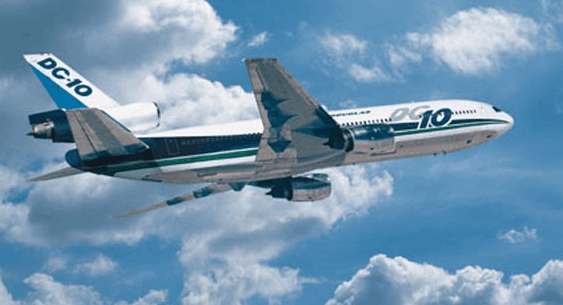| Manufacturer: Boeing (McDonnell Douglas) |
Country of Origin: USA |
Model: DC-10

Information:
DC-10 Overview
A new category
of airplane was added to the world's air transportation system when
the DC-10 entered scheduled airline service. It has been demonstrating
its value to airlines and air travelers since then, winning world
recognition for its reliability, comfort and efficiency in more than
23 million hours of revenue flight.
In addition
to the luxury and spaciousness inherent in its wide cabin, the three-engine
DC-10 incorporated improvements in propulsion, aerodynamics, structure,
avionics, flight control systems and environmental compatibility that
advanced industry standards.
The multirange
DC-10 was designed and built in Long Beach, California, by Douglas
Aircraft Company, now the Douglas Products Division of the Boeing
Commercial Airplane Group. Production was started in January 1968
and first deliveries were in 1971. In a production run extending to
1989, 386 commercial DC-10s were delivered, plus 60 KC-10 tanker/cargo
models built for the U.S. Air Force.
Six
Models
Six commercial
models of the DC-10 were developed. All versions of the trijet transport
accommodate from 250 passengers, in a typical mixed first class and
coach arrangement, to 380 in all-economy seating.
- The Series 10 model
was designed for service on routes of up to 4,000 statute miles
(6,436 km) and is powered by General Electric CF6-6 engines, each
rated at 40,000 pounds (17,144 kg) takeoff thrust. The first flight
was made on Aug. 29, 1970. Federal Aviation Administration (FAA)
certification was received for airline service on July 29, 1971.
First deliveries were made jointly to American Airlines and to United
Airlines. Scheduled commercial flights began Aug. 5, 1971.
- The intercontinental
range Series 40, powered by Pratt & Whitney JT9D turbofan engines,
with nonstop range up to approximately 5,800 miles (9,322 km), was
introduced to service in 1972.
- The Series 30, an
intercontinental model with a range of approximately 5,900 miles
(9,493 km), also introduced in 1972, is equipped with General Electric
CF6-50 fanjets.
- The DC-10 Convertible
Freighter, first delivered in 1973, can be arranged to carry all
passengers or all cargo and is available in the basic Series 10,
Series 30 or Series 40. All versions have available cargo space
of more than 16,000 cubic feet (452.8 m3), as much capacity
as four 40-foot (12.19-m) railroad freight cars, or up to 380 passengers.
- The Series 15, launched
in 1979, combines the basic smaller airframe of the Series 10 with
a version of the more powerful engines used on the longer-range
Series 30s. The combination gives the Series 15 outstanding performance
with full loads from high-altitude airports in hot climates.
- The DC-10 Series
30F, an all-freighter model, was ordered by Federal Express in May
1984. First delivery was made Jan. 24, 1986. This pure freighter
version will carry palletized payloads of up to 175,000 pounds (79,380
kg) more than 3,800 miles (6,115 km).
A military
variant of the DC-10 is the U.S. Air Force KC-10 tanker/cargo aircraft,
adapted from the Series 30CF for aerial refueling and cargo transport.
Sixty were built and delivered to the Air Force.
Advanced
Propulsion
The DC-10's
General Electric and Pratt & Whitney power plants represented
significant advances in engine performance and technology over earlier
jet engines. The high-bypass-ratio turbofans yield lower specific
fuel consumption, lower noise levels, smokeless exhaust, easier maintenance
and design for high reliability. Thrust ratings range from 40,000
to 54,000 pounds (17,144 to 24,494 kg). Two engines are mounted beneath
the wings; the third is above the aft fuselage at the base of the
vertical stabilizer.
Interior
The wide DC-10
cabin interior with its broad ceiling results in a roomy spaciousness.
Two aisles run the length of the cabin. Aisles and seats are wider
than those on earlier jet transports, providing a level of passenger
comfort and convenience that set a new standard in air travel. Galleys
can be installed on the lower deck or in a section of the aft cabin,
both areas well separated from passengers. An advanced air conditioning
and cabin pressurization system provides separate automatic temperature
controls for the three main cabin sections and for the cockpit and
lower galley, ensuring optimum comfort for all passengers, regardless
of load density in the different areas.
Flight
Deck
The roomy
flight deck of the DC-10 has stations for a three-member crew, plus
seating for two observers. Prime considerations in cockpit design
were simplicity, efficiency and low crew workload. Large windshields
provide exceptional visibility, particularly during approaches, landings
and ground maneuvering. The DC-10 is certified for automatic landing
under Category IIIA weather conditions, allowing operation in near-zero
visibility.
Good
Neighbor
The airplane
was designed specifically to be a "good airport neighbor,"
operating from existing runways, taxiways and loading areas. Although
each engine produces more than twice as much takeoff thrust as the
most powerful engines on first-generation jetliners, the DC-10 power
plants are significantly quieter. The DC-10 was the first commercial
transport to be certified under the stringent FAA Stage 3 regulations
governing sound levels for new aircraft, and it also complies with
international noise standards.
|





